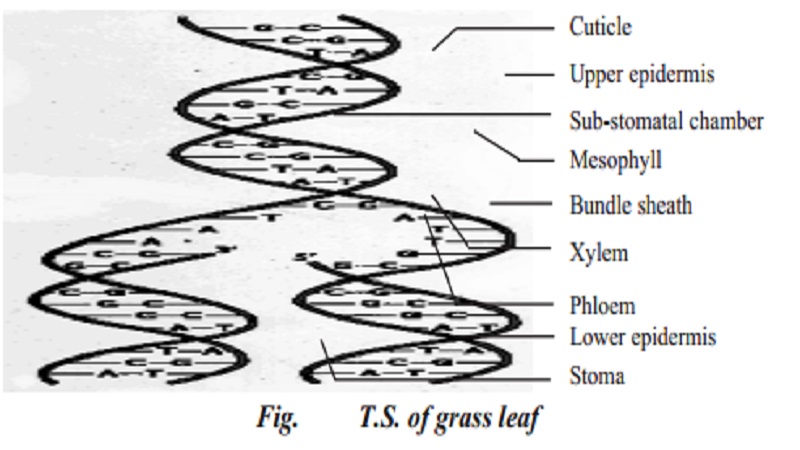Chapter: 11 th 12th std standard Bio Botany plant tree Biology Higher secondary school College Notes
Anatomy of a monocot leaf - Grass leaf

Anatomy of a dicot and monocot leaves
Leaves are very important vegetative organs because they are mainly concerned with photosynthesis and transpiration. Like stem and roots, leaves also have the three tissue systems - dermal, ground and vascular. The dermal tissue system consists of an upper epidermis and lower epidermis. Stomata occur in both the epidermis but more frequently in the lower epidermis. The ground tissue system that lies between the epidermal layers of leaf is known as mesophyll tissue. Often it is differentiated into palisade parenchyma on the adaxial (upper) side and spongy parenchyma on the abaxial (lower) side.
A leaf showing this differentiation in mesophyll is designated as dorsiventral. It is common in dicot leaves. If mesophyll is not differentiated like this in a leaf (i.e., made of only spongy or palisade parenchyma) as in monocots, it is called isobilateral. The mesophyll tissue, especially spongy parenchyma cells enclose a lot of air spaces. The presence of air spaces is a special feature of spongy cells. They facilitate the gaseous exchange between the internal photosynthetic tissue (mesophyll) and the external atmosphere through the stomata.
The vascular tissue system is composed of vascular bundles. They are collateral and closed. The vascular tissue forms the skeleton of the leaf and they are known as veins. The veins supply water and minerals to the photosynthetic tissue. Thus the morphological and anatomical features of the leaf help in its physiological functions.
Anatomy of a monocot leaf - Grass leaf
A transverse section of a grass leaf reveals the following internal structures.
Epidermis
The leaf has upper and lower epidermis.They are made up of a single layer of thin walled cells. The outer walls are covered by thick cuticle. The number of stomata is more or less equal on both the epidermis. The stomata are surrounded by dumb-bell shaped guard cells. The guard cells contain chloroplasts, whereas the other epidermal cells do not have them. Some special cells bound the guard cells. They are distinct from other epidermal cells. These cells are called subsidiary cells or accessory cells. Some cells of upper epidermis are large and thin walled. They are called bulliform
cells or motor cells. These cells are helpful for the rolling and unrolling of the leaf according to the weather change. Some of the epidermal cells of the grass are filled with silica. They are called silica cells.
Mesophyll
The ground tissue that is present between the upper and lower epidermis of the leaf is called mesophyll. Here, the mesophyll is not differentiated into palisade and spongy parenchyma. All the mesophyll cells are nearly isodiametric and thin walled. It is for this reason, the grass leaf is described as isobilateral. These cells are compactly arranged with limited intercellular spaces. They contain numerous chloroplasts.
Vascular bundles
Vascular bundles differ in size. Most of the vascular bundles are smaller in size. Large bundles occur at regular intervals.
Two patches of sclerenchyma are present above and below the large vascular bundles. These sclerenchyma patches give mechanical support to the leaf. The small vascular bundles do not have such sclerenchymatous patches.
Vascular bundles are conjoint, collateral and closed. Each vascular bundle is surrounded by a parenchymatous bundle sheath. The cells of the bundle sheath generally contain starch grains. The xylem of the vascular bundle is located towards the upper epidermis and the phloem towards the lower epidermis.
Related Topics